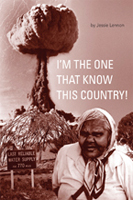I'm the one that know this country! (Second edition)
Summary
Matutjara woman, Jessie Lennon, was born on a sheep station near Kingoonya in the 1920s.
Aged six, she accompanied her father on a ceremonial journey with the Old People, as far west as Ooldea, in the time of Daisy Bates, and north to Coober Pedy, then a fledgling opal-mining settlement.
Her early life was spent travelling with family: on foot, on camels and sometimes ‘jumping the train’. Later they sought whitefella work in towns on sheep and cattle stations. Many times Jessie’s travel brought her back to Coober Pedy where she lived in camps, underground dugouts and on the mine dumps.
In the 1950s, Jessie and her family were ‘caught by the bomb’: fallout from the British nuclear tests at Emu, north of Maralinga. They were not evacuated, nor advised to take any precautions, and although they fled east, they could not escape the long-term effects on their health. Decades later, Jessie and Senior Elders in the community took up an unsuccessful fight for compensation.
Jessie Lennon is a natural storyteller and here she speaks in Aboriginal English and language. As readers we gain an Anangu perspective of extraordinary adaption, as the Anangu make first contact with Europeans. But her story also reveals another viewpoint, that of settler history: the growth of the pastoral and mining industries, as well as the construction of railway lines and highways.
In I’m the One… Jessie’s stories are juxtaposed with historical photographs and information of the times, places and people in her life. In a life full of journeys and homecomings, a vivid picture emerges of family life and the importance of ‘home’.
Jessie Lennon was an Aboriginal woman of the Western Desert. For much of her long life she travelled, lived and worked in the vast desert regions of South Australia. This was her country, and from a young age she knew it intimately. Jessie’s first book was And I Always Been Moving! She wrote this story for her family — and for the latecomers: those who ‘don’t yet know these things'.
